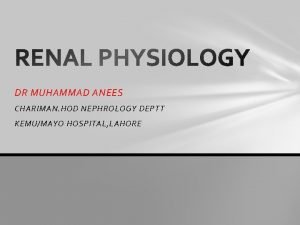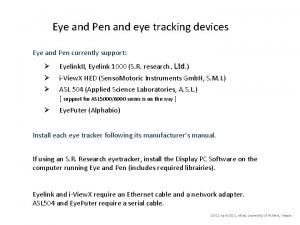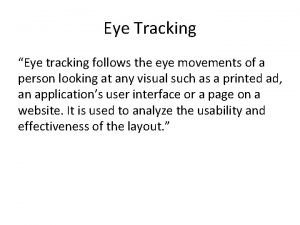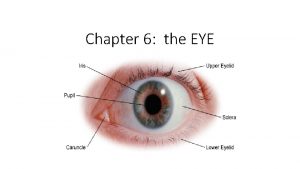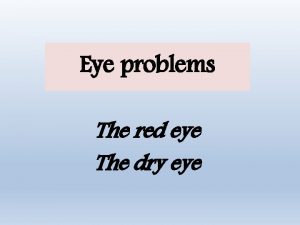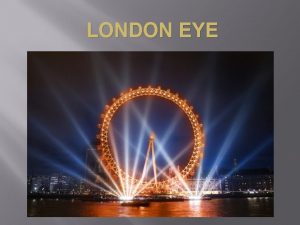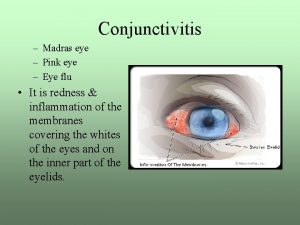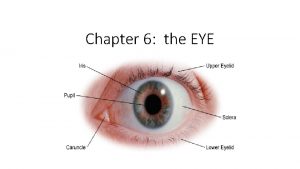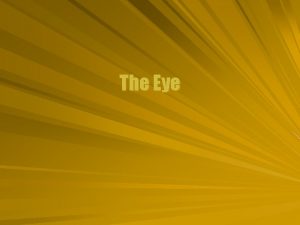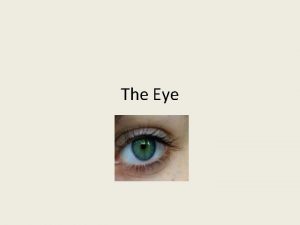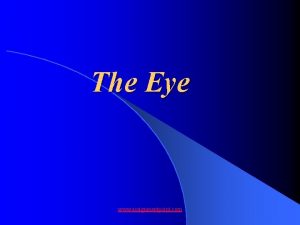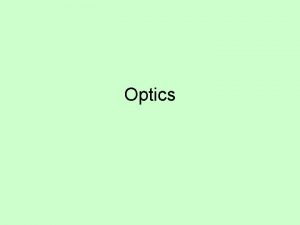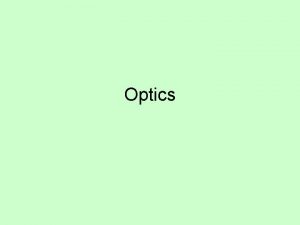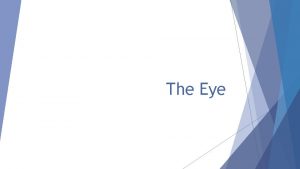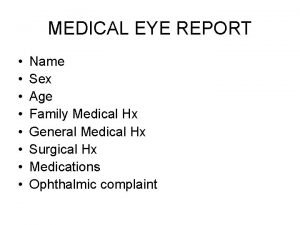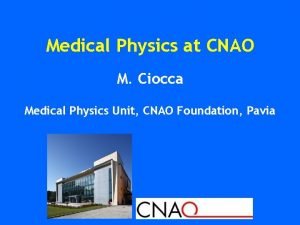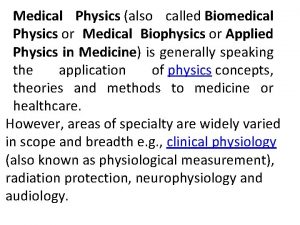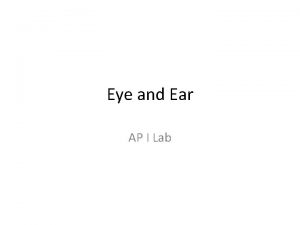Medical Physics Contents Physics of the Eye and



































- Slides: 35

Medical Physics

Contents Physics of the Eye and Ear n Biological Measurement and Imaging n

The Eye Ciliary muscles relax (lens flattens) distant objects n Ciliary muscles contract (lens gets fat) close up objects n Refraction at cornea produces inverted image on retina n

The Eye n Dim light: iris dilates to allow light in - rods operative (see in black & white) n Bright light: iris contract to avoid light flooding - cones are sensitive to either red, green & blue light n Colour seen depends on proportion in which each type of cone is stimulated

The Eye Nerve ends respond to changes in light intensity n Eye is constantly scanning so that new nerves are stimulated n Persistence of vision: limited response of eye due to delay times in between nerve ending responses n n If the eye is focused on a near object in bright light, distant objects are visible reasonably clearly. If the eye focuses on the same object at the same distance in dim light, distant objects are blurred. The depth of field is reduced

Defects of Vision & Their Correction n Convex Lens: light rays converge Power (Dioptres, D) = 1 / focal length (m)

Defects of Vision & Their Correction n Concave Lens: light rays diverge Power (Dioptres, D) = 1 / focal length (m) focal length is negative as focus is virtual (virtual image)

Defects of Vision & Their Correction n Lens Formula: 1/f = 1/v + 1/u v = image distance, u = object distance M = v/u M = magnification (no units) n Myopia (short sightedness): cornea too curved or lens too powerful distant object images form in front of retina and blur n Hypermetropia (long sightedness): eye not powerful enough near object images form behind retina and blur

Physics of the Ear Sound: longitudinal wave Acoustic impedance: density multiplied by the speed of sound in the material - low conducts sound well - high insulates sound well n Intensity: power per unit area (decreases with distance from source) Pinna: funnels sound waves into ear canal Canal: increases sound intensity Tympanic membrane vibrates Ossicles (three small bones) vibrate Strike oval window of the cochlea Nerve cells detect sound & convert it into electrical impulses for processing by the brain n n

Physics of the Ear Place Theory: brain determines pitch by noting the place on the basilar membrane where the message is strongest n Frequency Theory: frequency of vibrations of the basilar membrane as a whole is translated into an equivalent frequency of nerve impulses n Neurons, however, cannot fire as rapidly as the frequency of the highest-pitched sound volley principle: nerve cells fire in sequence to send a rapid series of impulses to the brain n Intensity is measured on the decibel scale:

Physics of the Ear n Hearing Loss: - mechanical damage due to a blow on the head - disease (stop ossicles from moving) - exposure to excessive noise (tinnitus) - ageing

Nerve Impulses n n n n Electrical Signals in the Body: carried by neurones - cells have membrane potential: extra K+ ions inside, Na+ ions outside potential difference = 70 m. V When membrane is stimulated: - becomes permeable to Na+ions which diffuse due to the negative charge Potential rises initially to 0 m. V (depolarisation) & then to +30 m. V (reverse polarisation) Membrane becomes impermeable to Na+ ions & they are trapped within nerve cell K+ions diffuse out of the membrane which restores the potential (repolarisation) Process takes about 2 ms Then the K+ions are pumped out, process takes about 50 ms

Nerve Impulses n Pumps materials as a fluid quickly around body n Double circulatory system:

Nervous Impulses Deoxygenated blood enters through the vena cava into the right atrium Oxygenated blood enters through the pulmonary veins into the left atrium It’s then pumped through a valve into the right ventricle chamber It’s then pumped through a valve into the left ventricle And then up through the pulmonary valve into the pulmonary artery towards the lungs And then through the aortic valve and out of the aorta to the rest of the body

Nerve Impulses Arteries carry blood away from the heart at high pressure in thick walled lumen Capillaries have thin walls to allow glucose and oxygen to diffuse through Veins carry low pressure blood back to the heart. Veins have thinner walls and valves to prevent backflow of blood

Nerve Impulses

Nerve Impulses n Carry blood at high pressure n Outermost layer is composed of connective tissue Media – smooth muscle cells and elastic tissue Intima – in direct contact with flow of blood Lumen – cavity in which blood flows n n n

Nerve Impulses Most exchange of nutrients and gases takes place here n Small diameter, large surface area for diffusion n n Lungs carbon dioxide is exchanged for oxygen Tissues O 2, CO 2, nutrients and wastes are exchanged Kidneys wastes are released to be eliminated from body Intestine nutrients are picked up, wastes are released

Nerve Impulses n Electrocardiogram (ECG): allows doctors to look at the electrical behaviour of the heart to diagnose problems - Body fluids transmit some of the electrical activity to the surface - Signals are reduced in size, with amplitudes of about 1 m. V - Suitable ECG output: patient must be relaxed so nerve cell activity does not disrupt data of electrical activity of heart P wave: depolarisation & contraction of the atria QRS wave: depolarisation & contraction of the ventricles T wave: re-polarisation and relaxation of the ventricles

Ultrasound n Ultrasound: sounds above the audible frequency range for humans n Uses: non-invasive imaging, used to detect distances, depths and for medical purposes n Generation & Detection: ultrasound probe (transducer) generates & detects ultrasound waves, usually by use of a piezoelectric transducer. A voltage is induced when a quartz crystal is stretched or compressed, which can be large enough to create a spark. If a voltage is applied to a piezoelectric material, it changes shape. For an alternating voltage, the crystal will vibrate. Maximum energy transfer occurs when the crystal is in resonance

Ultrasound n n n n Ultrasound is often used to detect functions inside the body: Ultrasound is: longitudinal passed through a gel on the skin to prevent reflection reflected as it passes from one tissue to another (velocity change) absorbed by tissue material absorbed & reflected by many percentages depending on the tissue type This determines an overall image when the wave is connected to a receiver

Ultrasound n Resolution: distinction of image using ultrasound e. g. what distance in the body does a pixel on the monitor show? n higher frequency = better resolution Axial: use short pulses; determined resolution in direction of beam n Lateral: use narrow pulses; determined by beam width n n A-scan: amplitude modulated display n B-scan: brightness modulated display

Ultrasound Real time B-scan: moving images. Up to 100 probes are used n Movement of blood: through Doppler effect n Advantages: n low frequency (low energy) beam n non-invasive & no discomfort n more effective than X-ray for images of soft tissue n portable equipment Disadvantages: n skilful operator & image requires skilful interpretation n image resolution is very easily reduced

Medical Optics Optical fibre: glass rod that conducts light by TIR n Light travels down a core surrounded by glass cladding: slightly lower refractive index (n) prevents loss of light energy if the core passes into material of a higher refractive index n Snell’s Law: n Critical Angle: n n 1 sinθ 1 = n 2 sinθ 2 sinθc = n 2/n 1

Medical Optics n If the fibre is bent sharply significant loss of light - radius of bend must be 20 x diameter to prevent such losses sheath optical fibre optic light guide Fibre diameter: 10μm n Endoscope of 3 mm diameter would have approx. 40 000 fibres n The more fibres, the greater the resolution n

Medical Physics n n n Uses of Endoscopy: cut out diseased tissue take a biopsy seal a site of bleeding with heat remove an obstructive object keyhole surgery

Medical Physics n LASER: light amplification by stimulated emission of radiation - When a photon of the right wavelength hits an excited atom of certain materials, it can stimulate the emission of a second photon of exactly the same wavelength and phase as the first - If enough atoms are excited, the photons can stimulate further emissions of further photons, all travelling in the same direction. - At one end of the material there is a mirror that totally reflects the photons, while at the other is a mirror that partially reflects the photons

Medical Physics n Properties of lasers: - monochromatic (single colour) - coherent (in phase) - produce continuous light (pulses are caused by shutters) - absorbed by skin: increased by melanin - used in fibre optics to help guide light beam - CO 2 lasers cut away delicate tissue e. g. brain n Safety issues: - severe & deep burns caused by beams - beam shined into eye will cause blindness

n X-Rays Uses - identify bone fractures - identify tooth decay - identify tumours & disease in soft tissue - treatment of tumours by radiotherapy X-rays: photons of em radiation produced when a target of heavy metal is struck by electrons travelling at high speed. Approx. 1% of the electrons produce an X-ray photon the rest is lost in heating up the target n Production of X-rays: - decrease velocity of electron or - remove an inner electron. Electrons replace the inner electron & photons are emitted as the electrons undergo transitions from different energy levels n

X-Rays n Maximum energy: all electron’s energy is converted into the photon’s energy - Kinetic energy = photon energy - Kinetic energy = charge of electron × voltage e. V = hf and… c = fλ so… e. V = hc/λ h = Planck’s constant

X-Rays n Generation of X-rays: - rotating anode tube evacuated glass tube, cooled in oil with a lead surround - Hot filament boils off electrons which are accelerated by anode voltage - hit target; most are released as heat, but few become X-ray - to prevent melting, target spins on a motor at 3000 rpm

X-Rays n Controlling the X-rays: - cannot be focused - sharp images are produced by small sources (point source) n Absorption of X-rays: occurs when x-rays pass through materials due to energy loss by… - Scattering: X-ray photons are reradiated as lower energy photons - Ejection: X-rays are ejected (photoelectric effect). Photons of visible light are emitted as atom comes out of the excited state - Compton Scattering: electron & lower energy X-ray photon are emitted - Pair Production: V. high energy photon interacts with atom’s nucleus. Electron & positron emerge, losing energy by ionisation until the positron is annihilated by an electron generates 2 identical photons

X-Rays n Dangers of X-rays: - water ionises to produce free radicals which produce H 2 O 2 - enzymes & DNA are damaged - parts of cells are damaged - cell division is damaged ( mutations) - tissue & organ damage - life expectancy shortens - mutations cause gene alterations in populations n Attenuation of X-rays: - inverse square law: intensity reduces with distance I = I 0 e -μ x

X-Rays n Uses of X-rays: - diagnosis - treatment of cancers (radiotherapy) with high energy X-rays n X-ray workers… 1) wear a film badge to check the amount of radiation they get 2) wear lead aprons while the machine is in use 3) verify that the machine is in an enclosed room and the controls are in a separate room 4) ensure that there is no entry into the X-ray room while the machine is in use

Summary n n n n The Eye Defects of Vision & Their Correction Physics of the Ear Nervous Impulses Ultrasound Medical Physics X-Rays
 Birds eye view camera shot
Birds eye view camera shot Hammurabi
Hammurabi Hammurabi code eye for an eye
Hammurabi code eye for an eye Anemia eyes vs normal
Anemia eyes vs normal Hammurabi code an eye for an eye
Hammurabi code an eye for an eye An eye for an eye a tooth for a tooth sister act
An eye for an eye a tooth for a tooth sister act Blue eyes dominant or recessive
Blue eyes dominant or recessive An eye for an eye meaning
An eye for an eye meaning Every eye is an eye
Every eye is an eye Difference between medical report and medical certificate
Difference between medical report and medical certificate Hát kết hợp bộ gõ cơ thể
Hát kết hợp bộ gõ cơ thể Lp html
Lp html Bổ thể
Bổ thể Tỉ lệ cơ thể trẻ em
Tỉ lệ cơ thể trẻ em Chó sói
Chó sói Glasgow thang điểm
Glasgow thang điểm Hát lên người ơi alleluia
Hát lên người ơi alleluia Môn thể thao bắt đầu bằng từ đua
Môn thể thao bắt đầu bằng từ đua Thế nào là hệ số cao nhất
Thế nào là hệ số cao nhất Các châu lục và đại dương trên thế giới
Các châu lục và đại dương trên thế giới Công thức tính độ biến thiên đông lượng
Công thức tính độ biến thiên đông lượng Trời xanh đây là của chúng ta thể thơ
Trời xanh đây là của chúng ta thể thơ Cách giải mật thư tọa độ
Cách giải mật thư tọa độ Làm thế nào để 102-1=99
Làm thế nào để 102-1=99 Phản ứng thế ankan
Phản ứng thế ankan Các châu lục và đại dương trên thế giới
Các châu lục và đại dương trên thế giới Thể thơ truyền thống
Thể thơ truyền thống Quá trình desamine hóa có thể tạo ra
Quá trình desamine hóa có thể tạo ra Một số thể thơ truyền thống
Một số thể thơ truyền thống Bàn tay mà dây bẩn
Bàn tay mà dây bẩn Vẽ hình chiếu vuông góc của vật thể sau
Vẽ hình chiếu vuông góc của vật thể sau Thế nào là sự mỏi cơ
Thế nào là sự mỏi cơ đặc điểm cơ thể của người tối cổ
đặc điểm cơ thể của người tối cổ Ví dụ giọng cùng tên
Ví dụ giọng cùng tên Vẽ hình chiếu đứng bằng cạnh của vật thể
Vẽ hình chiếu đứng bằng cạnh của vật thể Tia chieu sa te
Tia chieu sa te



